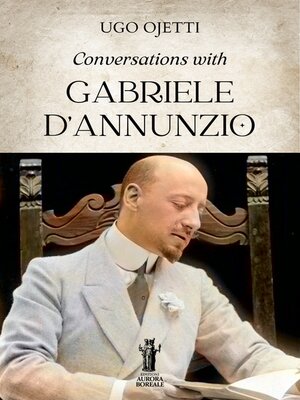
Sign up to save your library
With an OverDrive account, you can save your favorite libraries for at-a-glance information about availability. Find out more about OverDrive accounts.
Find this title in Libby, the library reading app by OverDrive.



Search for a digital library with this title
Title found at these libraries:
| Library Name | Distance |
|---|---|
| Loading... |
Ugo Ojetti (1871-1946), a writer, journalist, and art critic, was one of the most interesting protagonists of Italian culture in the first half of the twentieth century.
From his essay Alla scoperta dei letterati (1895), we have selected the Colloqui con Gabriele D'Annunzio, which constitute one of its most interesting chapters. These are precious pages that present us with the figure of a young D'Annunzio, who at thirty-two was already one of the leading figures on the Italian literary and cultural scene; a D'Annunzio who had risen to prominence in the intellectual and social environment of a Rome that had recently become the capital, where his refined and communicative style, his worldview, and the central core of his poetics were already being fully forged. He had already published some of his greatest masterpieces, including Il piacere, which had guaranteed him great literary success, and was about to publish Le vergini delle rocce. This was a D'Annunzio who still had a long way to go in what would prove to be a tumultuous, passionate, adventurous life, studded with successes, loves, military exploits, and revolutionary experiences.
As D'Annunzio himself states in these conversations with Ojetti, "The new Renaissance will therefore have to begin by re-establishing the cult of Man. And the new artists, like the old ones, will ask science for the faculty to create: that is, to continue Nature, to add to Nature higher souls and nobler forms, to manifest the Ideal through luminous signs".
From his essay Alla scoperta dei letterati (1895), we have selected the Colloqui con Gabriele D'Annunzio, which constitute one of its most interesting chapters. These are precious pages that present us with the figure of a young D'Annunzio, who at thirty-two was already one of the leading figures on the Italian literary and cultural scene; a D'Annunzio who had risen to prominence in the intellectual and social environment of a Rome that had recently become the capital, where his refined and communicative style, his worldview, and the central core of his poetics were already being fully forged. He had already published some of his greatest masterpieces, including Il piacere, which had guaranteed him great literary success, and was about to publish Le vergini delle rocce. This was a D'Annunzio who still had a long way to go in what would prove to be a tumultuous, passionate, adventurous life, studded with successes, loves, military exploits, and revolutionary experiences.
As D'Annunzio himself states in these conversations with Ojetti, "The new Renaissance will therefore have to begin by re-establishing the cult of Man. And the new artists, like the old ones, will ask science for the faculty to create: that is, to continue Nature, to add to Nature higher souls and nobler forms, to manifest the Ideal through luminous signs".







